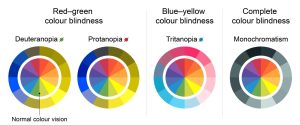Chapter 6: Color Vision
6.1. Importance of Color Perception
Color is a visual tool that allows us to more easily navigate the outside world. We use it in various ways every day and tend not to think twice about it. Here are a few aspects of color vision that help us in our daily lives.
Object Detection and Recognition
Color allows us to notice and identify objects in a space. Some colors, like red, capture our attention more readily than others (Etchebehere & Fedorovskaya, 2017) , and so are frequently used for warning signs (Dewar & Pronin, 2023).
Scene Segmentation
Color also supports our ability to separate objects in a space. We are aware that the red ball is separate from the orange block and the blue pyramid because they are not the same color (Figure 6.1). This difference in hue makes it easier for us to recognize the shapes as individuals and analyze them as such. Their color also allows us to separate the shapes from the green background. Indeed one suggestion is that color vision in humans may have evolved in humans because it helps to easily distinguish ripe fruit from the leaves that it grows among (Sumner & Mollon, 2000). Presumably those individuals with better color vision were more likely to be adequately fed and so would be more likely to be healthy enough to have children.

Health and Mating
Color is a primary tool used across cultures and animal species to identify the health of an individual. For example, someone with greenish skin may be seen as unwell and potentially in need of medical attention. White-skinned individuals are generally perceived as looking more healthy when their skin tone is reddish or yellowish in tone (Stephen et al., 2009).
For non-human animals, the use of color not only indicates health but also acts as a tool to attract suitable mates. The peacock is one of the most common examples, the males carrying large fans of multicolored feathers.
Aesthetics
Many colors and color combinations are generally pleasing to the eye (Figure 6.2).

Color can help us in many other ways too, such as identifying dangerous plants and animals (a yellow and red spider is way more threatening then a light brown one); food finding (yellow bananas are normal, teal ones probably aren’t edible); and space illusions (color on a ceiling makes a room feel smaller).
Color deficiencies can have a strong influence on how a person experiences color. Often these deficiencies are confused with “color-blindness.” However, color blindness is a complete lack of color sensation, where an individual sees only in grayscale. This is a rare condition characterized by nonfunctional cones, or even a complete lack of cones altogether (the person only has rods). This can also result from traumatic brain injuries, such as oxygen deprivation (see Figure 6.3). In Figure 6.4, we see that people who have more typical color vision deficiencies, can see color but they often confuse some of them.


